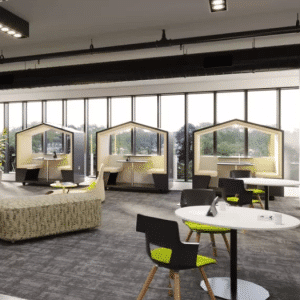 Creating working environments where people can thrive, maximising productivity and preserving health and wellbeing, has always been the purpose of ergonomics and human factors.
Creating working environments where people can thrive, maximising productivity and preserving health and wellbeing, has always been the purpose of ergonomics and human factors.
But over the decades we have seen this evolve from a focus on physical comfort and safety, to more latterly, encompassing mental wellbeing too. The next phase, we would argue, is encompassing diversity of the mind, as well as the body – ‘ergonomics for neurodiversity’ to coin a phrase.
Over the last few years, our understanding and cultural acceptance of neurodiversity have advanced rapidly, with some estimates placing the proportion of the population with some form of neurodivergence as high as one in five.
It follows that savvy businesses are turning their attention to accommodating these natural variations in human neurological traits, seen in conditions such as Autism Spectrum Disorder (ASD), Attention Deficit Hyperactivity Disorder (ADHD), dyslexia, and more.
So, what do businesses need to understand about neurodivergent team members, and what needs to change to create more inclusive work settings where neurodivergent employees can thrive?

Offices can be noisy, lively locations – made especially evident by the contrast with homeworking in recent years. While many people noticed the noise and distraction more acutely after returning to their post-Covid offices, those with neurodivergent traits found the demands of dealing with this kind of environment more than just irritating: the increased cognitive load can take a real toll, leading to more anxiety, fatigue and, in some cases, potential behavioural changes and poor mental health.
When thinking about neurodiversity, the key is in the name – diversity. You will never create one space that suits everyone but, by offering a choice of provisions, such as alternative spaces or the ability to adjust the environment, you can accommodate a wider range of minds and personalities.
There are some key areas employers can consider:

Sensory-friendly environments: Consider reducing noise levels and avoiding harsh lighting, powerful colours and strong smells/perfumes which can be stressors for those with sensory and/or information-processing differences. Creating quiet zones/pods, where sensory input is minimised, can be useful.
Clear communication and expectations: Transparent communication and formalising and articulating ‘workplace norms’. For example, providing clear guidelines around email/communication etiquette defines expectations and can help minimise misunderstandings.
Consider the proxemics: Make allowances for the different amounts of space that people feel they need between themselves and others due to cultural and/or neurological differences.
Communication via multiple modalities: Investing in technology such as text-to-speech software or adaptive communication tools, can support not only those with neurodivergent traits but those with visual and auditory impairment too.
Neurodiversity awareness training: Training programs for managers and staff can promote understanding and empathy, fostering an inclusive and supportive work culture.

Crucially, for an accepting and inclusive approach to neurodiversity to prevail, it must be championed at every level of an organisation, starting from the top with leaders promoting an inclusive culture where diverse voices are heard and valued.
Seeing the benefits
Just as we begin to recognise the challenges, we are also becoming aware of the unique strengths those with neurodivergent traits possess. Research has shown that this can help boost productivity and innovation in the workplace.
If employers can successfully navigate this new frontier and provide inclusive working environments which help their people perform at the peak of their powers, the potential benefits to health and wellbeing, as well as productivity, innovation and problem-solving, could be enormous.